engine oil HONDA PILOT 2013 2.G Owners Manual
[x] Cancel search | Manufacturer: HONDA, Model Year: 2013, Model line: PILOT, Model: HONDA PILOT 2013 2.GPages: 488, PDF Size: 10.18 MB
Page 17 of 488

16
Quick Reference Guide
Maintenance (P377)
Under the Hood (P389)
●Check engine oil, engine coolant, and windshield washer
fluid. Add when necessary.●Check brake fluid.
●Check the battery condition monthly.
aPull the hood release handle under the corner of the
dashboard.
bLocate the hood latch lever, pull the lever up, and lift up
the hood.
cWhen finished, close the hood and make sure it is firmly
locked in place.
Lights (P402)
●Inspect all lights regularly.
Wiper Blades (P410)
●Replace blades if they leave
streaks across the windshield.
Tires (P414)
●Inspect tires and wheels regularly.●Check tire pressures regularly.
●Install snow tires for winter
driving.
Page 66 of 488

65
Safe Driving
Exhaust Gas Hazard
Carbon Monoxide Gas
The engine exhaust from this vehicle contains carbon monoxide, a colorless,
odorless, and highly toxic gas. As long as you properly maintain your vehicle, carbon
monoxide gas will not get into the interior.
■Have the exhaust system inspected for leaks whenever
•The exhaust system is making an unusual noise.
•The exhaust system may have been damaged.
•The vehicle is raised for an oil change.
When you operate a vehicle with the tailgate open, airflow can pull exhaust gas into
the interior and create a hazardous condition. If you must drive with the tailgate
open, open all the windows and set the climate control system as shown below.
1.Select the fresh air mode.
2.Select the mode.
3.Set the fan speed to high.
4.Set the temperature control to a comfortable setting.
Adjust the climate control system in the same manner if you sit in your parked
vehicle with the engine running.
1Carbon Monoxide Gas
An enclosed area such as a garage can quickly fill up with carbon monoxide gas.
Do not run the engine with the garage door closed.
Even when the garage door is open, drive out of the garage immediately after starting the engine.
3WARNING
Carbon monoxide gas is toxic.
Breathing it can cause unconsciousness and
even kill you.
Avoid any enclosed areas or activities that
expose you to carbon monoxide.
Page 69 of 488
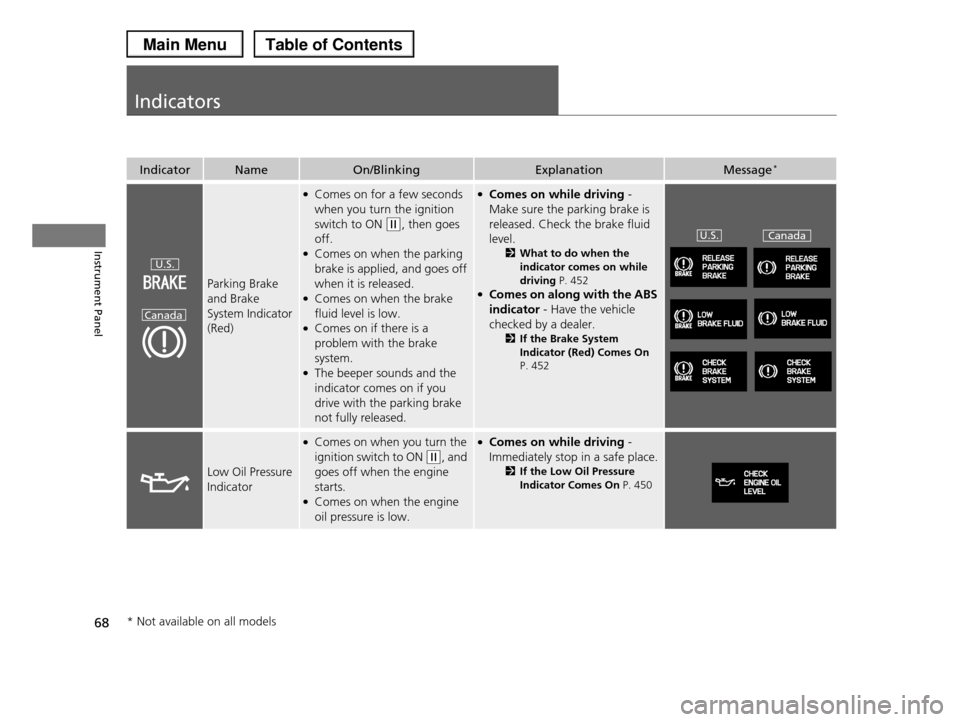
68
Instrument Panel
Indicators
IndicatorNameOn/BlinkingExplanationMessage*
Parking Brake
and Brake
System Indicator
(Red)
●Comes on for a few seconds
when you turn the ignition
switch to ON (w, then goes
off.●Comes on when the parking
brake is applied, and goes off
when it is released.●Comes on when the brake
fluid level is low.●Comes on if there is a
problem with the brake
system.●The beeper sounds and the
indicator comes on if you
drive with the parking brake
not fully released.
●Comes on while driving -
Make sure the parking brake is
released. Check the brake fluid
level.
2What to do when the
indicator comes on while
driving P. 452●Comes on along with the ABS
indicator - Have the vehicle
checked by a dealer.
2If the Brake System
Indicator (Red) Comes On
P. 452
Low Oil Pressure
Indicator
●Comes on when you turn the
ignition switch to ON (w, and
goes off when the engine
starts.●Comes on when the engine
oil pressure is low.
●Comes on while driving -
Immediately stop in a safe place.
2If the Low Oil Pressure Indicator Comes On P. 450
U.S.
Canada
U.S.Canada
* Not available on all models
Page 82 of 488
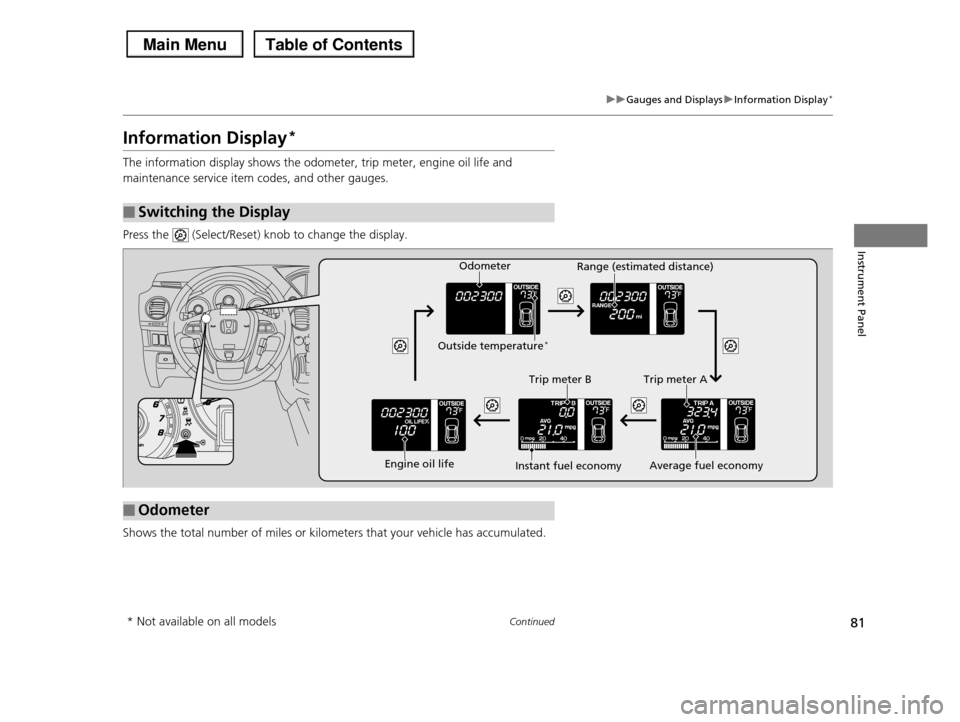
81
uuGauges and DisplaysuInformation Display*
Continued
Instrument Panel
Information Display*
The information display shows the odometer, trip meter, engine oil life and
maintenance service item codes, and other gauges.
Press the (Select/Reset) knob to change the display.
Shows the total number of miles or kilometers that your vehicle has accumulated.
■Switching the Display
■Odometer
Engine oil life
Trip meter B
Average fuel economy
Trip meter A
Instant fuel economy
Range (estimated distance)
Outside temperature*
Odometer
* Not available on all models
Page 83 of 488
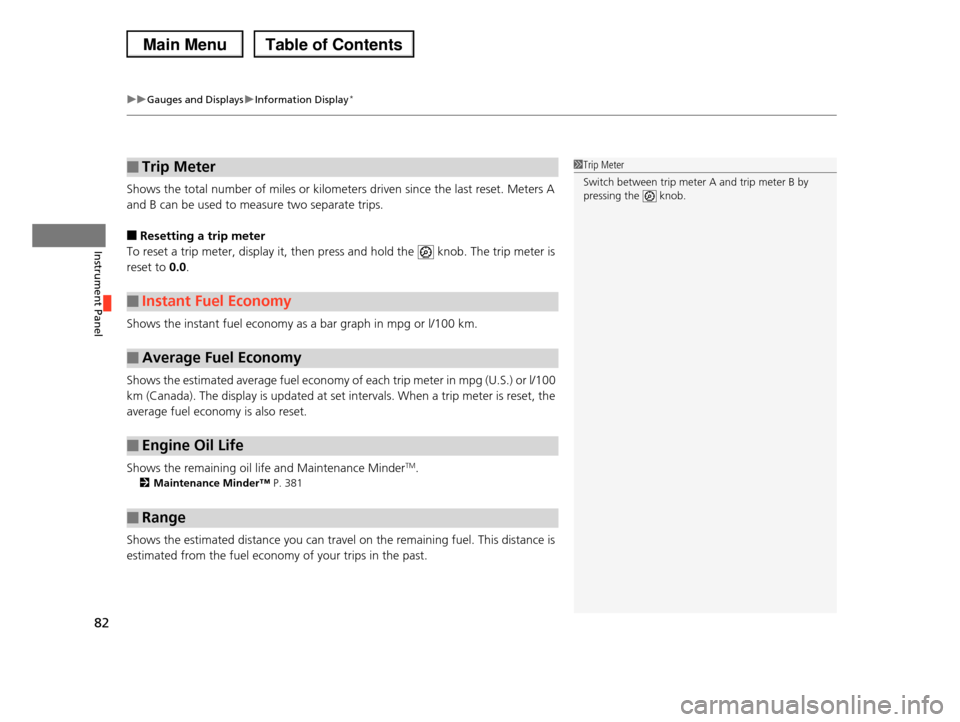
uuGauges and DisplaysuInformation Display*
82
Instrument Panel
Shows the total number of miles or kilometers driven since the last reset. Meters A
and B can be used to measure two separate trips.
■Resetting a trip meter
To reset a trip meter, display it, then press and hold the knob. The trip meter is
reset to 0.0.
Shows the instant fuel economy as a bar graph in mpg or l/100 km.
Shows the estimated average fuel economy of each trip meter in mpg (U.S.) or l/100
km (Canada). The display is updated at set intervals. When a trip meter is reset, the
average fuel economy is also reset.
Shows the remaining oil life and Maintenance MinderTM.
2Maintenance Minder™ P. 381
Shows the estimated distance you can travel on the remaining fuel. This distance is
estimated from the fuel economy of your trips in the past.
■Trip Meter
■Instant Fuel Economy
■Average Fuel Economy
■Engine Oil Life
■Range
1Trip Meter
Switch between trip meter A and trip meter B by pressing the knob.
Page 86 of 488

85
uuGauges and DisplaysuMulti-Information Display*
Continued
Instrument Panel
Multi-Information Display*
Shows the odometer, trip meter, outside temperature indicator, and other gauges.
It also displays important messages such as warnings and other helpful information.
Press the / (information) button or the SEL/RESET button to change the
display.
■Switching the Display
SEL/RESET Button
Tire Pressure Monitor / Button
Engine oil lifeTrip meter B
Trip meter A
Odometer
Customize Settings
Trip Computer
* Not available on all models
Page 90 of 488

89
uuGauges and DisplaysuMulti-Information Display*
Continued
Instrument Panel
Shows the remaining oil life and Maintenance MinderTM.
2Maintenance Minder™ P. 381
■Engine Oil Life
Page 365 of 488
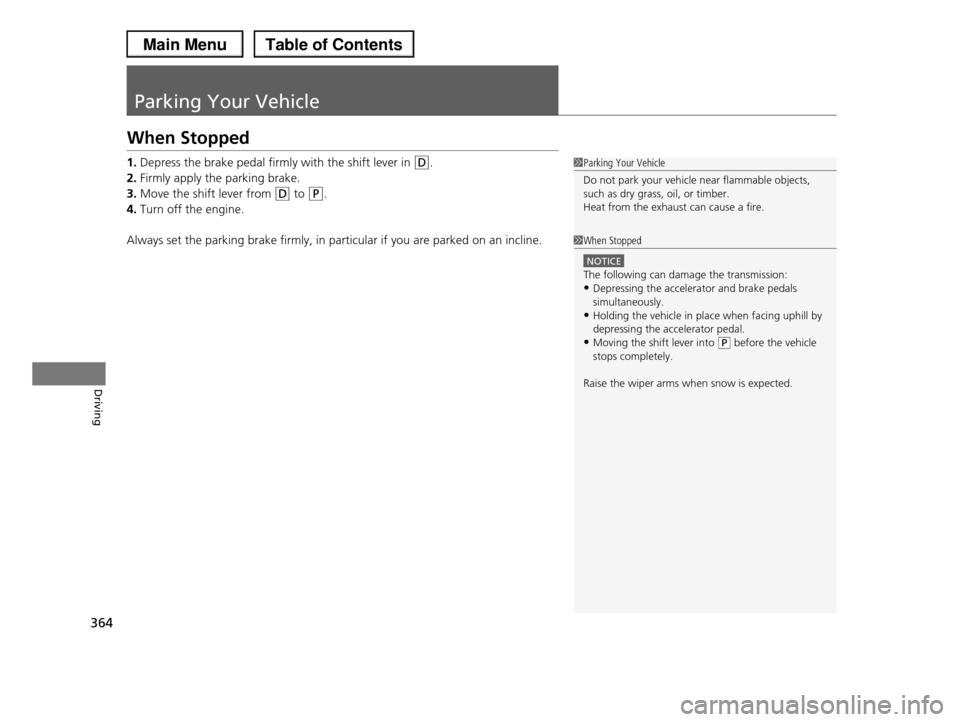
364
Driving
Parking Your Vehicle
When Stopped
1.Depress the brake pedal firmly with the shift lever in (D.
2.Firmly apply the parking brake.
3.Move the shift lever from (D to (P.
4.Turn off the engine.
Always set the parking brake firmly, in particular if you are parked on an incline.
1Parking Your Vehicle
Do not park your vehicle near flammable objects,
such as dry grass, oil, or timber.
Heat from the exhaust can cause a fire.
1When Stopped
NOTICE
The following can damage the transmission:
•Depressing the accelerator and brake pedals
simultaneously.
•Holding the vehicle in place when facing uphill by depressing the accelerator pedal.
•Moving the shift lever into (P before the vehicle
stops completely.
Raise the wiper arms when snow is expected.
Page 375 of 488
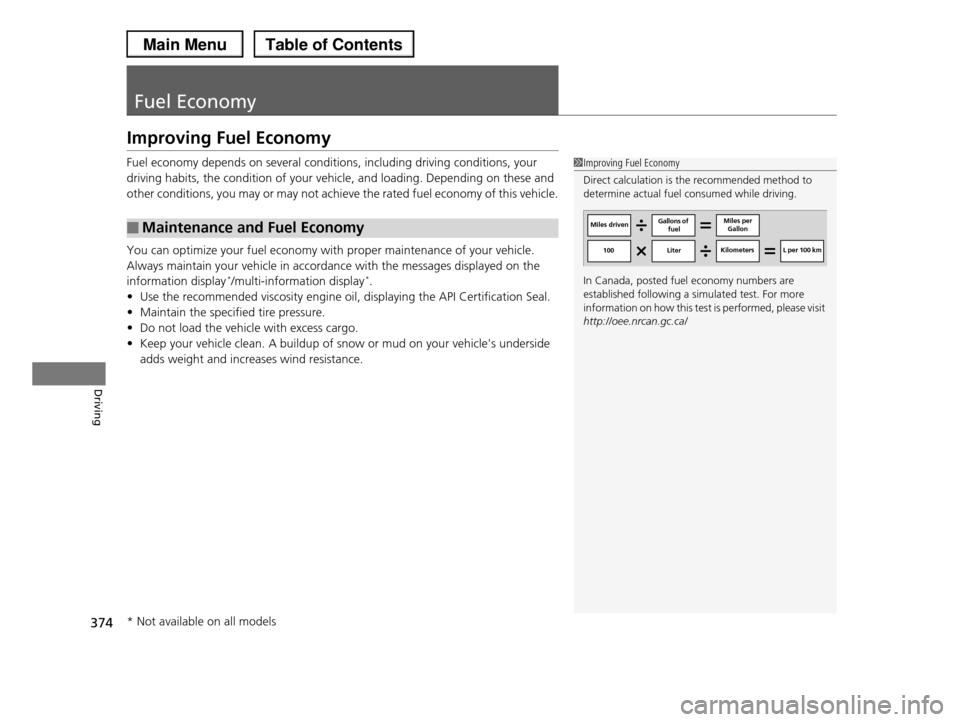
374
Driving
Fuel Economy
Improving Fuel Economy
Fuel economy depends on several conditions, including driving conditions, your
driving habits, the condition of your vehicle, and loading. Depending on these and
other conditions, you may or may not achieve the rated fuel economy of this vehicle.
You can optimize your fuel economy with proper maintenance of your vehicle.
Always maintain your vehicle in accordance with the messages displayed on the
information display*/multi-information display*.
•Use the recommended viscosity engine oil, displaying the API Certification Seal.
•Maintain the specified tire pressure.
•Do not load the vehicle with excess cargo.
•Keep your vehicle clean. A buildup of snow or mud on your vehicle's underside
adds weight and increases wind resistance.
■Maintenance and Fuel Economy
1Improving Fuel Economy
Direct calculation is the recommended method to
determine actual fuel consumed while driving.
In Canada, posted fuel economy numbers are
established following a simulated test. For more
information on how this test is performed, please visit http://oee.nrcan.gc.ca/
Miles drivenGallons of fuelMiles per Gallon
100LiterKilometers L per 100 km
* Not available on all models
Page 378 of 488
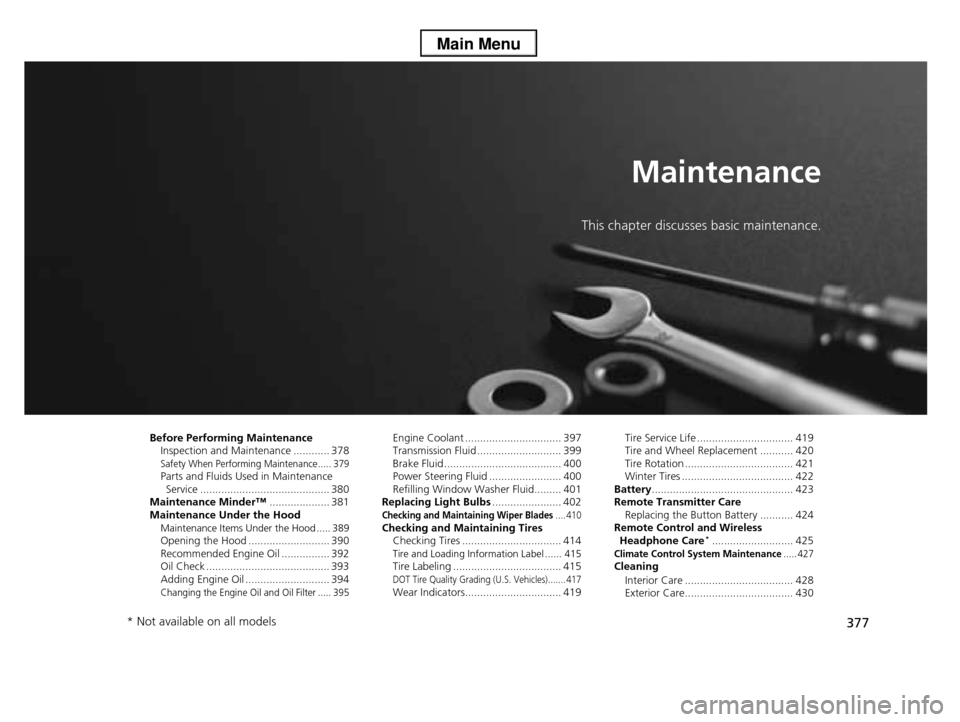
377
Maintenance
This chapter discusses basic maintenance.
Before Performing MaintenanceInspection and Maintenance ............ 378Safety When Performing Maintenance..... 379Parts and Fluids Used in Maintenance Service ........................................... 380Maintenance Minder™.................... 381Maintenance Under the HoodMaintenance Items Under the Hood ..... 389Opening the Hood ........................... 390 Recommended Engine Oil ................ 392 Oil Check ......................................... 393Adding Engine Oil ............................ 394Changing the Engine Oil and Oil Filter ..... 395
Engine Coolant ................................ 397Transmission Fluid ............................ 399Brake Fluid ....................................... 400 Power Steering Fluid ........................ 400 Refilling Window Washer Fluid......... 401Replacing Light Bulbs....................... 402Checking and Maintaining Wiper Blades.... 410Checking and Maintaining TiresChecking Tires ................................. 414Tire and Loading Information Label ...... 415Tire Labeling .................................... 415DOT Tire Quality Grading (U.S. Vehicles)....... 417Wear Indicators................................ 419
Tire Service Life ................................ 419Tire and Wheel Replacement ........... 420Tire Rotation .................................... 421 Winter Tires ..................................... 422Battery............................................... 423Remote Transmitter CareReplacing the Button Battery ........... 424Remote Control and Wireless Headphone Care*........................... 425Climate Control System Maintenance..... 427Cleaning
Interior Care .................................... 428 Exterior Care.................................... 430
* Not available on all models